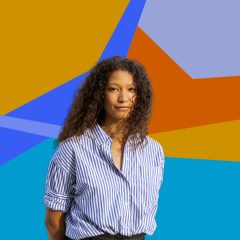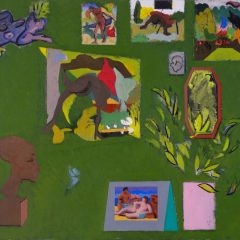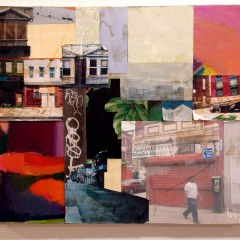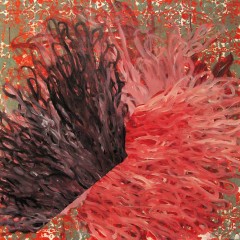The shamanistic power of totems is transformed in the art of three women exhibiting this month at the University City Arts League. Drawing on methods and materials that belong to women’s craft practices and exploring the relationship of bodies to clothing, the three have created armor and stand-ins for the female body that are imbued with magical forces to be reckoned with.
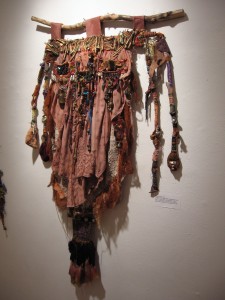
The show features work by two Philadelphia artists–Martina Johnson-Allen and Gretchen Shannon–and one outlander, Kooki Davis. Philadelphia storyteller Linda Goss, who has worn work from both Davis and Shannon for her costuming, curated.
Martina Johnson-Allen rocks the exhibit, mixing beauty and power, merging female with male imagery to create something new. Much of her work relates to women’s clothes and women’s roles, with a fierceness and control that is rare and magical. Her inspired apron of ripped strips of cloth threatens and protects. The cloth construction and coloring puts me in mind of photographer Pieter Hugo’s portraits of dangerous-looking African hyena men and hunters, whose fabric and leather clothing hangs with amulets. This piece, Haint’s Apron Replete with Chemotherapy Dreds II, is the signature work for the show, a sewn and ripped article of clothing associated with repetitive domestic chores. But the implied repetition here is not chores but rituals; the earthy colors, animal and natural amulets transformed the apron’s humble associations into a vector of power to heal.
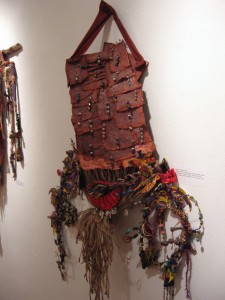
I keep thinking of the relationship of what Johnson-Allen is doing to what Tlingit contemporary artist Tommy Joseph did with his hand-painted three-piece suit now on view at the Fabric Workshop. The merger of clothing, performance, ritual and ancestral pull confronting the norms of another culture gives power to both artists and their work.
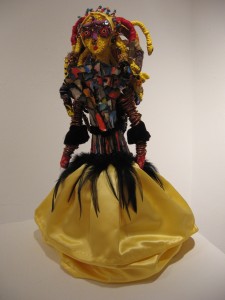
Johnson-Allen, Penn State (BA, el. ed.) and UArts (MFA, art ed. and printmaking), has received a couple of Guggenheims and has shown in numerous museums, from the Philadelphia Museum of Art to the Smithsonian’s National Museum of American Art to the American Craft Museum in New York. A long-time, highly regarded presence in the African-American art community, Johnson-Allen’s work is extraordinary. While her work has earned her some wider regard, she still is not a name on the tip of every tongue that talks about art in this city or in this country. She ought to be. There is a racial divide, there is a gender divide, and there is a craft-as-medium divide that makes her work hit the trifecta of exclusion. That she has had the degree of recognition she has speaks to the quality of her work and its ability to transcend categorization and just be what it is–terrific art.
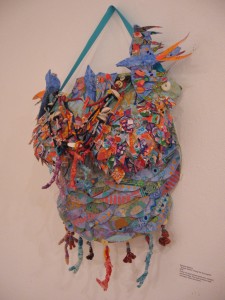
Gretchen Shannon’s objects that protect the body, are more traditionally feminine and more traditionally stitched. Yet much of this work also is more than that. A fabric of hanging-hand amulets and a flurry of buttons and other objects cover a hard plaster female breastplate, a surprising mix of the sweet and disturbing.
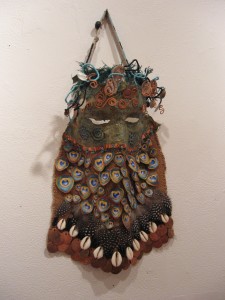
My favorite of Shannon’s masks suggests Mardi Gras coquetry and decoration while delivering a mix of threat and protection. Shannon’s work is inconsistent, but the best of it merges delicacy and toughness, especially when it reaches beyond conventional imagery into metaphor.
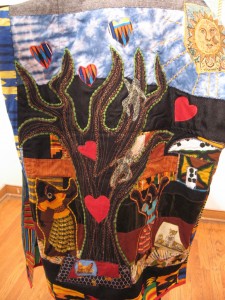
Kooki Davis, who makes narrative jackets for Goss to perform in also incorporates magic in her stitchery enterprise. Her Ancestry and Innovation garment, made of piecework, applique and embroidery, is notable for the way the embroidery turns the tree into a sinewy presence. This work was meant to support a performance and not necessarily stand on its own (it was created for Goss’ performance at the Delaware Art Museum in 2009), but in person it has the magic of texture that gets flattened even further in my digital photo. So it suffers here from a double whammy. I am sorry I missed Goss performing in the jacket!
The work in the show has a strong African-American aesthetic and influence–from jujus and nkisis to choice of imagery and bright color. (Even Shannon, the only person associated with the show who is not African American, has included some African imagery; in the breastplates, she merged the primal protective hands of African art, for example, with Western concepts of pretty classical form and sweet colors in a successful juxtaposition). The themes of women’s needlecraft, women’s bodies, and the function of clothes as ritual objects are also important to all three artists in the show.
This is Linda Goss’ first-time outing as a curator and it’s a stretch in quality and boldness for the UCAL.
The show is open to Oct. 30, 2009. Even though the gallery hours are generous, the gallery space sometimes goes to other activities, so call first.
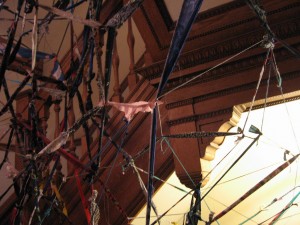
Also, while I’m talking about UCAL, there’s another ritual-related installation–a webbing of torn and knotted fabric strips by Lauren Comito and Megan Bartley-Matthews (they were both in a class I taught with Roberta at Tyler several years ago and in this context I ought to mention neither is a woman of color), called the Trends of City Sprawl. The fabric spiderwebs its way from the front porch, where it’s starting to weather and droop, through the mail slot of the front door and up the stairs of the Arts League. It’s an interactive network (you, too, can add fabric–bring it along with you) that reminds me of the Shinique Smith‘s fabric bales that reference the international rag trade. It also brought to mind various knot-tying customs as well as the Lace in Translation show over at the Design Center at Philadelphia University.
This is up to Oct. 31.


